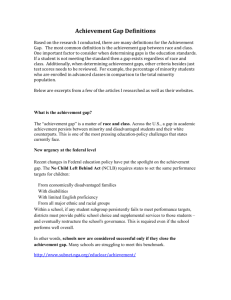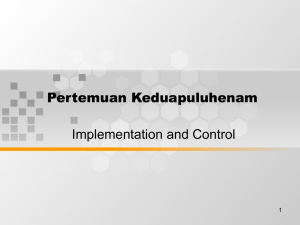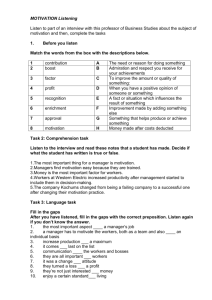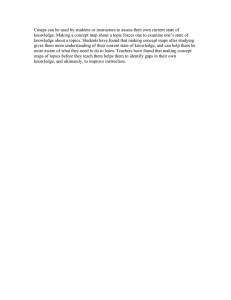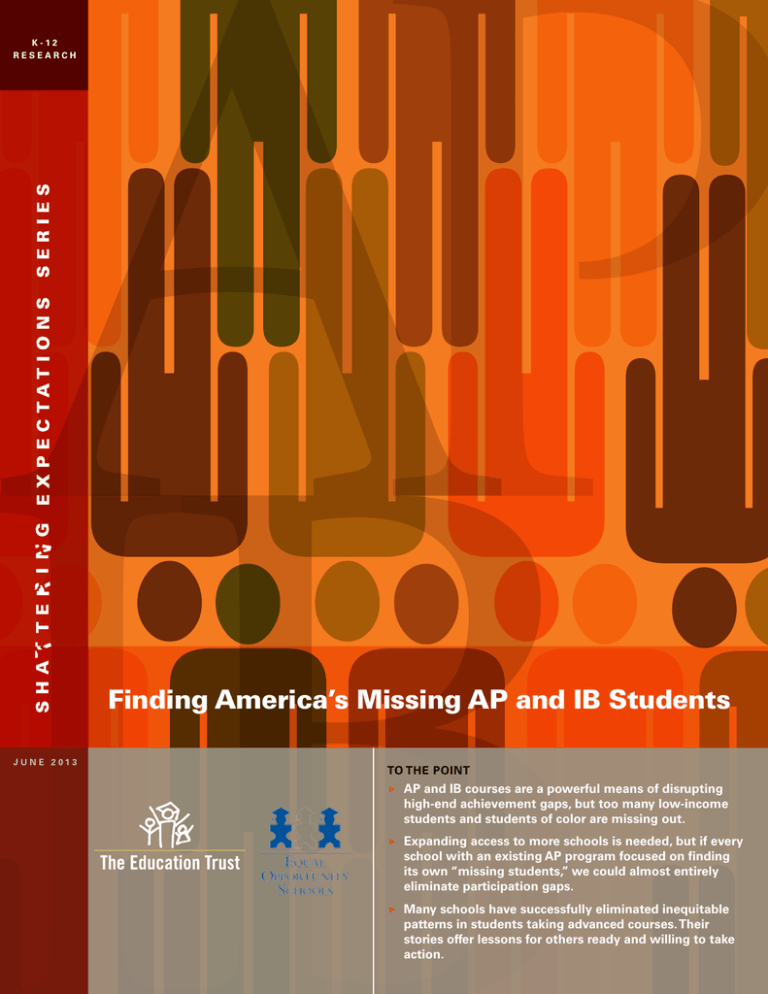
K-12
research
Finding America’s Missing AP and IB Students
june 2013
To the point
AP
and IB courses are a powerful means of disrupting
high-end achievement gaps, but too many low-income
students and students of color are missing out.
Expanding
access to more schools is needed, but if every
school with an existing AP program focused on finding
its own “missing students,” we could almost entirely
eliminate participation gaps.
Many
schools have successfully eliminated inequitable
patterns in students taking advanced courses. Their
stories offer lessons for others ready and willing to take
action.
Finding America’s Missing AP and IB Students
B y C h r i s t i n a t h e o ka s a n d r e i d s aa r i s
Visit a local high school and ask to sit in on one of their
best, most challenging classes. More often than not, you’ll
be shown an Advanced Placement (AP) or International
Baccalaureate (IB) course. Designed to provide a head start
on a college education, these classes conclude with rigorous, externally scored examinations, success on which can
earn students college credit. In addition to helping students prepare for college-level work, they increase students’
chances of college admission and success.
In our report, we examine AP/IB participation patterns
nationally and then by school to estimate how many students are missing out. We try to determine if the gaps are
the result of spotty AP course availability in schools serving
concentrations of black, Hispanic, American Indian, and
low-income students, or if the gaps are primarily caused
by an enrollment problem, meaning these students are in
schools with AP courses but are not enrolled in them.
It turns out that, each year, more than half a million lowincome students and students of color are “missing” from
AP and IB participation — students who would benefit
from these advanced opportunities if they participated
at the same rate as other students. It also turns out that
expanding AP to more schools is only a small part of
the solution. The data show that if every school with an
existing AP program focused on finding its own “missing
students,” we could almost entirely eliminate the national
participation gaps. For IB, an emphasis on expansion
remains a worthy goal, as less than 5 percent of high
schools have a program (compared to 71 percent with AP).
But in those schools already offering an IB program, equitable access is a problem (see Figure 3).
First-time visitors to such classes are likely to be impressed.
The teachers are engaging, the intellectual rigor is high,
and the assignments are challenging. What you won’t see,
however, are many black, Hispanic, or low-income students. Fortunately, these patterns have not gone unnoticed;
federal and state governments, districts, and even the private sector have stepped up to help expand access believing
in the worthiness of advanced study. However, virtually
every analysis finds continued gaps in participation rates in
these courses by race and family income levels (see Figure
1 for our analysis of national AP participation data). Lost
in these participation gaps are real students. Lost, too, are
some of the reasons why these gaps persist, despite the
effort to close them.
Although we have a long way to go before AP and IB participation gaps are closed, there is some encouraging news in
the school-level data: Many schools have eliminated gaps
in participation by race and family income, and others are
moving in that direction. For example, 10 percent of high
schools nationally have no missing low-income students.
In these schools, the participation of poor students in the
… each year, more than half a million
low-income students and students of
color are “missing” from AP and IB
participation …
Figure 14: National participation rates and gaps
Overall
11.7%
Asian
25.1%
White
11.9%
American
Indian
6.3%
Hispanic
9%
37,394 missing
Black
6%
5,920 missing
2.9% Gap
5.4% Gap
79,016 missing
5.9% Gap
Low Income
5.5%
520,464 missing
Non Low Income
15.6%
10.1% Gap
Participation in the AP program represents a small part of the student body; slightly more than 1 in 10 students participate. Clearly, some subgroups are
more likely to participate, including Asian and middle and high-income students. White students participate at the average and low-income, black, and
American Indian students are the least likely to participate; slightly more than 1 in 20 students. Gaps represent large numbers of students.
This Ed Trust report was written by Christina Theokas, director of research at The Education Trust, and Reid Saaris, executive director of Equal
Opportunity Schools. For a full copy, visit www.edtrust.org/sites/edtrust.org/files/Missing_Students.pdf
The Education Trust | Shattering expectations series | june 2013
© Copyright 2013 The Education Trust. All rights reserved.
Figure 25: Number of missing students due to AP participation gaps within schools
= 10,000 Students
Low-Income
467,496
Black
89,025
American
Indian
614,445
Total
Missing
Students
*Low-income
numbers
The school-by-school
analysisinclude
unmasks students
some of
from
all races,
while
thethat
remaining
the
differences
among
schools
the national
analysis
not reveal.
Participation
vary
Black,does
Hispanic
and
Americanrates
Indian
widely across schools. A number of schools have
students are from families that are not
no missing students.
low-income.
If within-school gaps were closed, the national
missing-student Hispanic and black gaps would
close completely, and the low-income gap would
nearly close (90 percent).
3,301
Hispanic
54,623
AP program is equal to or greater than that of students who
are not low income.
Lessons from schools that have closed their gaps suggest
there are some steps districts and high schools can take
immediately to remove barriers that are contributing to
inequitable participation patterns.
Figure 3: Number of missing students due to
IB participation gaps within schools.
= 1,000 Students
District and high school educators can:
• Examine their data and start asking questions
• Audit program entry requirements
• Examine what students and teachers know about accessing the AP/IB program
• Consider expectations and long-held beliefs about
which students should participate
• Think about how to improve readiness and the pipeline prior to high school
• Set a specific, near-term goal to find missing AP/IB
students and clearly articulate that goal.
Now that we know the problem exists both between and
within schools, there is more work to be done by policymakers as well.
Policymakers can:
• Be vocal about gaps at the high end
• Make sure all high school students have access
• Ensure grant programs that fund AP/IB programs focus
on equitable participation
• Require that all high schools offer a minimum number
of AP/IB classes and provide necessary support
• Report participation and success rates in courses offered
for all student groups at the school level
• Identify diverse schools and districts that have narrowed
or eliminated these gaps
• Take action.
Low SES
Black
Hispanic
American
Indian
19,715
7,932
5,376
171
33,194
Total Missing Students*
*Low-income numbers include students from all races, while the
remaining Black, Hispanic and American Indian students are from
families that are not low-income.
Data show that AP/IB opportunity gaps exist in many
places, between schools, among types of programs offered,
and within schools. There are immediate actions that can
be taken right now to improve the experiences of many
students.
This report is part of Ed Trust’s Shattering Expectations
series. For more about the series, visit www.edtrust.org.
The Education Trust |Shattering expectations series | june 2013
About The Education Trust
About Equal Opportunity Schools
The Education Trust promotes high academic
achievement for all students at all levels — prekindergarten through college. We work alongside
parents, educators, and community and business
leaders across the country in transforming schools
and colleges into institutions that serve all students
well. Lessons learned in these efforts, together
with unflinching data analyses, shape our state and
national policy agendas. Our goal is to close the
gaps in opportunity and achievement that consign
far too many young people — especially those who
are black, Latino, American Indian, or from lowincome families — to lives on the margins of the
American mainstream.
Equal Opportunity Schools partners with school, district,
county, state, and national leaders around the country
to close race and income enrollment and success
gaps in their Advanced Placement and International
Baccalaureate programs. By identifying, enrolling, and
supporting missing students in challenging collegepreparatory courses, we boost their academic motivation
and achievement, and their likelihood of going to and
graduating from college.
ABOUT THIS SERIES
In this series, we will be producing reports focused on calling attention to gaps at
the high end of achievement and shattering expectations about the achievement
of our low-income students and students of color that have existed for far too
long. This is the second paper in the series; the first report, Breaking the Glass
Ceiling of Achievement for Low-Income Students and Students of Color, outlined
the progress and gaps that remain in which students reach advanced levels
of performance, as measured with the National Assessment of Educational
Progress. This report examines the high-end opportunity gap that exists in regard
to AP and IB course taking within our schools. Future papers will examine other
opportunity gaps, as well as the opportunity costs of certain course taking
patterns. Each report will provide examples of schools that are breaking these
long entrenched patterns and how they are helping all their students reach high
levels of performance. In general, papers in this series will focus on strategies for
increasing excellence and rigor in our schools, while also attending to equity.
1 2 5 0 H S t r e e t, N W, S u i t e 7 0 0 , Washin g t o n , D . C . 2 0 0 0 5
P 2 0 2 - 2 9 3 - 1 2 1 7 F 2 0 2 - 2 9 3 - 2 6 0 5 www . e d t r u s t. o r g

